
Alan
Dexter
Sugarbeet Weed Control Specialist
The designation on the teejet nozzles has a specific meaning. The first two numbers indicate the spray angle. An 8003 nozzle has an 80 degree spray angle at 40 psi. The E following the numbers means that the nozzle is an even spray nozzle and can be used for banding. The Delavan nozzle that is equivalent to the 8003E Teejet nozzle is the LE-3 80° . The LE-3 80° is an even spray nozzle with 0.3 gallons per minute capacity and 80° spray angle at 40 psi. The Delavan LF-3 25° and the 2502 Teejet nozzles listed in the table are flat spray nozzles which should not normally be used for banding. However, when the spray angle is as narrow as 25 degrees, then the spray pattern approaches an even spray nozzle and therefore can be used for banding. The narrow angle nozzles have a disadvantage since they must be positioned quite high for a 5 inch band and the spray particles would be more susceptible to drift. The Spraying Systems Conejet and the Delavan HC nozzles are hollow cone nozzles. The Conejet Y3 nozzle has a 58° Spray angle and would deliver 3 gallons per hour at 40 psi. The HC-3 45° nozzles will deliver 3 gallons per hour at 40 psi but would only have a 45° spray angle. Please note that the number on the hollow cone nozzles indicate gallons per hour and the number on the flat fan nozzles indicate gallons per minute.
Since all nozzles can be obtained in varying capacities, the desired capacity to accomplish a particular application must be calculated. The following formulas give a method for determining the desired capacity.
The formula to calculate the desired nozzle size for band application follows:

An example follows:
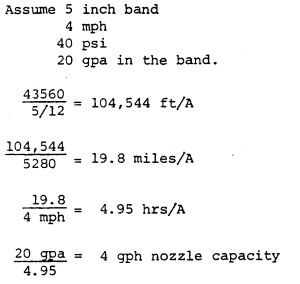
The height of a nozzle for a desired band width can be calculated as follows:
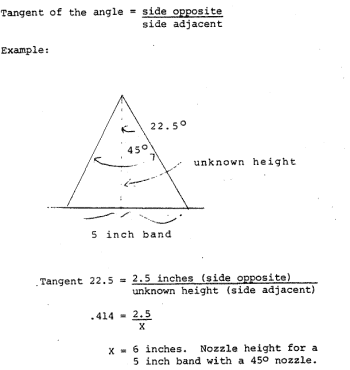
The tangent of angles can be found in tables of Trigometric Functions which are common in math books or in the Handbook of Chemistry and Physics.
The preceding formulas were used to calculate the information found in the following Table.
The preceding table could not possibly contain all possible nozzles, spray pressures, band widths, or operating speeds. This table can be used as a basis for calculating expected delivery rates from nozzles, pressures, bandwidths, or speeds not given in the table. When a calculation is made to change one factor, all other factors must be kept the same.
Different nozzles: Other unlisted nozzles with the same nozzle capacity as nozzles listed in the table will deliver the same gallons per acre if all of the conditions are kept the same. However, the spray angle may be different and the nozzle height would then need to be adjusted to get a 5 or 7 inch band. Delivery rate is directly proportional to gallons per acre delivered so delivery rate from nozzle sizes not listed can be calculated.
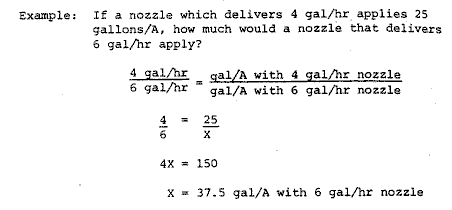
Different Spray Pressures: The following formula will give an estimate of the change in delivery rate for a change in pressure.
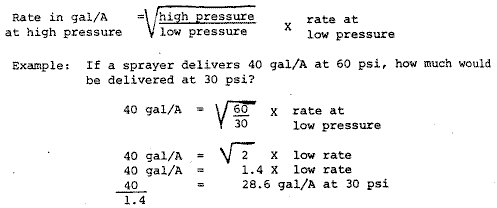
Different Band Widths: The delivery rate in gallons per treated acre is indirectly proportional to band width.
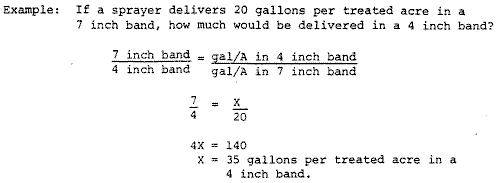
Different speeds: The delivery rate in gallons per acre is indirectly proportional to band width.
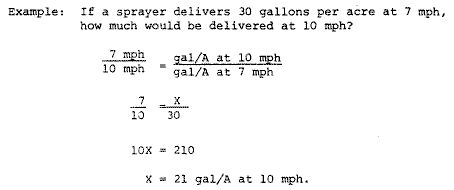
The data in the preceding Table must be confirmed by a field calibration. The data in the Table should be close enough to assist in nozzle selection and to confirm that the calculations from a field calibration are in the right range. Since variation in speedometers, variation in pressure gauges, and nozzle wear greatly affect the gallons per acre delivered by a sprayer, a sprayer cannot safely be calibrated by calculations. A field check on delivery rate must be made. The following section gives some possible methods for calibration.
Ground Sprayer-Calibration: The procedure for calibrating a sprayer
should not be difficult. Calibration is simply measuring the volume delivered by the
sprayer to a small part of an acre and then calculating how much would be delivered to the
entire acre.
The first step in any calibration procedure is to check the flow rate of all nozzles on
the sprayer. Any nozzles that are abnormal in delivery rate should be cleaned or if
cleaning does not correct the problem, replaced.
Three possible methods of calibrating a sprayer after checking nozzle delivery rate follow:
Method 1. |
|
| a) | measure out 660 feet in the field to be sprayed. |
| b) | fill spray tank up into the neck with water and mark the level of the water. |
| c) | spray over the 660 feet at the sprayer pressure and speed to be used for the field |
| d) | record the volume necessary to refill the spray tank to the level marked in step b. |
| e) |
calculate the amount of water applied per acre by using the
following formula. |
| f) | the width treated by the sprayer would be the boom width for a broadcast application. For banding, width would be band width in feet x number of bands. |
| a) | measure out 660 feet in the field to be sprayed. |
| b) | drive over the 660 feet with the sprayer but without spraying. Record the time required to travel the 660 feet at the speed which will be used for the field. |
| c) | with a stationary sprayer, catch the volume of water delivered from 2 to 4 nozzles in the length of time it took to travel over the 660 feet. Use the sprayer pressure which will be used in the field. |
| d) |
record the volume caught from the nozzles and calculate how
much would have been delivered from all nozzles using the following formula: |
| e) |
calculate the amount of water applied per acre by using the
following formula: |
| f) | the width treated by the sprayer would be the boom width for a broadcast application. For banding, width would be band width in feet x number of bands. |
| a) |
if some distance other than 660 feet would be easier to use,
then methods 1 and 2 can be used with a different distance but the formula for calculating
gallons per acre must be modified as follows: |
| b) | at least 300 feet should be used for a test run. |
An estimate of the number of gallons per acre applied by a sprayer can be obtained by using the gallons per minute rating of the nozzles on the sprayer For example, an 8004 nozzle will apply .4 gallons per minute at 40 pounds per square inch.
The estimate of gallons per acre can be obtained as follows:
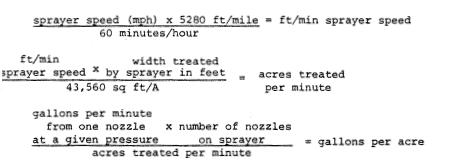
Since pressure gauges and speedometers vary considerably, this estimate of gallons per acre cannot be substituted for calibration.
1976 Sugarbeet Research and Extension Reports, Volume 7, Pages 58-65.